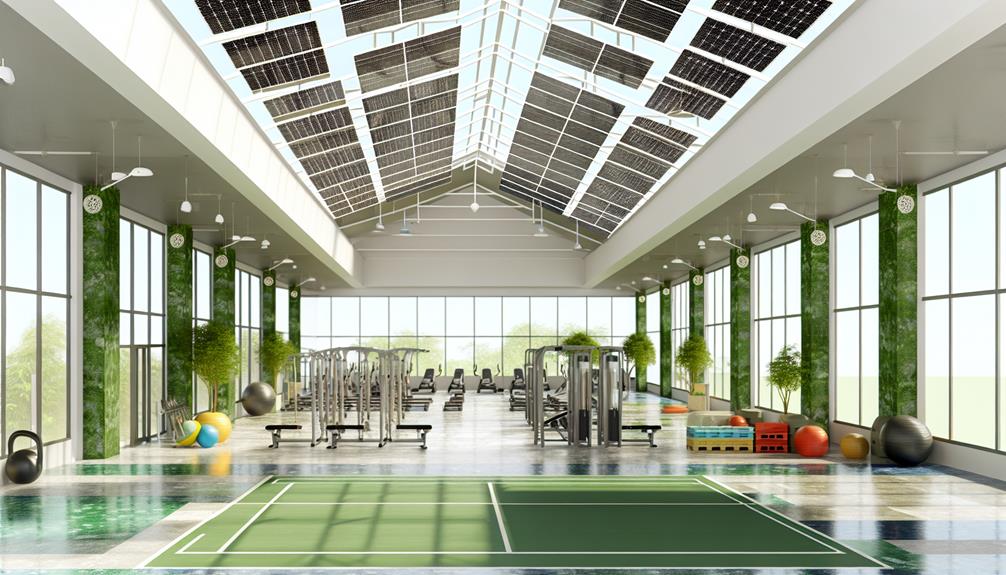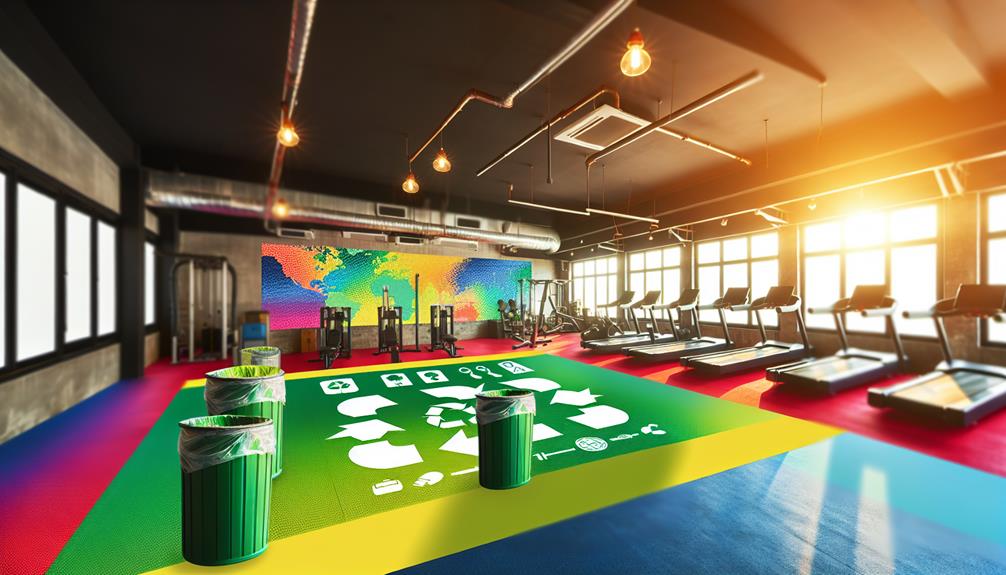Did you know that the fitness industry produces over 5 million tons of greenhouse gas emissions each year? With such a significant impact on the environment, it is crucial for fitness facilities to adopt sustainable practices and green initiatives. From energy-efficient equipment to waste reduction programs, there are various ways in which fitness centers can contribute to a healthier planet. In this discussion, we will explore the different aspects of sustainability in fitness and how these initiatives can not only benefit the environment but also enhance the overall fitness experience. So, let's dive into the world of sustainable fitness and discover how you can make a positive impact while pursuing your fitness goals.
Key Takeaways
- Energy-efficient fitness equipment can significantly reduce greenhouse gas emissions and energy costs in the fitness industry.
- Sustainable construction methods, such as using recycled or renewable materials, can minimize the carbon footprint of fitness facilities.
- Incorporating sustainable design elements, such as ergonomic equipment and energy-efficient lighting, can improve the overall workout experience and mental well-being of individuals.
- Implementing renewable energy sources like solar power and wind turbines can further reduce reliance on non-renewable energy sources and lower energy costs in fitness facilities.
- Waste reduction and recycling initiatives, including composting, upcycling, and comprehensive recycling programs, are essential in promoting a circular economy and proper waste management practices in the fitness industry.
Energy-Efficient Equipment
Investing in energy-efficient fitness equipment is a smart choice to reduce your carbon footprint and save on energy costs. Sustainable workout routines and energy-saving techniques are becoming increasingly popular as people become more conscious of their environmental impact. By choosing energy-efficient equipment, you can contribute to a greener future while still enjoying an effective workout.
Energy-efficient fitness equipment is designed to consume less energy without compromising on performance. These machines utilize advanced technologies that optimize energy usage, resulting in lower energy bills and reduced greenhouse gas emissions. Some examples of energy-saving techniques in fitness equipment include power-saving modes, automatic shut-off features, and LED displays that use less electricity.
Not only do energy-efficient fitness equipment benefit the environment, but they also provide a better workout experience. Many of these machines are equipped with features such as adjustable resistance levels, customizable workout programs, and interactive displays that track your progress. This allows you to personalize your workout, making it more engaging and effective.
In addition to reducing your carbon footprint and saving on energy costs, investing in energy-efficient fitness equipment can also inspire others to adopt sustainable workout routines. By leading by example, you can motivate your friends, family, and gym community to make eco-friendly choices in their fitness journeys.
Make a positive impact on the environment and your wallet by choosing energy-efficient fitness equipment. Embrace sustainable workout routines and energy-saving techniques to create a healthier planet for future generations.
Eco-Friendly Building Materials
Now let's explore how incorporating eco-friendly building materials into your fitness facility can further enhance your sustainability efforts. Sustainable construction methods are becoming increasingly popular in the fitness industry as businesses recognize the importance of reducing their environmental impact. By using eco-friendly building materials, you can minimize the carbon footprint of your facility while also creating a healthier and more sustainable environment for your clients.
One way to incorporate sustainable construction methods is by using materials that are made from recycled or renewable resources. For example, you can use reclaimed wood for flooring or furniture, or opt for bamboo, which is a fast-growing and renewable resource. Additionally, choosing materials that are locally sourced can further reduce transportation emissions.
In addition to using eco-friendly building materials, you can also consider implementing environmentally friendly workout gear. This can include using exercise equipment that is made from recycled materials or using energy-efficient lighting and HVAC systems. By making these choices, you can create a facility that not only promotes physical fitness but also contributes to a greener and more sustainable future.
Sustainable Fitness Center Designs

To create a sustainable fitness center, consider incorporating environmentally friendly design elements. These elements not only reduce the negative impact on the environment but also create a healthier and more inviting space for your members. Here are some design ideas to make your fitness center more sustainable:
- Ergonomic equipment: Invest in fitness equipment that is designed with ergonomic principles in mind. This not only ensures the comfort and safety of your members but also reduces energy consumption. Look for equipment with adjustable settings, energy-efficient features, and materials that are recyclable or made from sustainable sources.
- Biophilic design: Incorporate nature into your fitness center by incorporating biophilic design elements. This can include features such as indoor plants, natural lighting, and natural materials like wood and stone. Biophilic design has been shown to improve mental well-being, reduce stress, and increase productivity and focus.
- Energy-efficient lighting: Use energy-efficient lighting solutions, such as LED lights, throughout your fitness center. LED lights consume less energy and last longer than traditional lighting options. Additionally, consider installing motion sensors to automatically turn off lights in unoccupied areas, further reducing energy waste.
Renewable Energy Sources
To further enhance the sustainability of your fitness center, consider implementing renewable energy sources to reduce your reliance on traditional energy grids. Solar power and wind turbines are two popular options that can help you achieve this goal.
Solar power is a clean and abundant source of energy that can be harnessed using photovoltaic panels. By installing these panels on your fitness center's roof or in an open area nearby, you can generate electricity from the sun's rays. This not only reduces your carbon footprint but also lowers your energy costs in the long run.
Similarly, wind turbines can be installed in suitable locations to capture the power of the wind and convert it into electricity. These turbines are most effective in areas with consistent wind flow, such as coastal regions or open plains. By harnessing wind energy, you can further reduce your reliance on non-renewable energy sources and contribute to a greener future.
Waste Reduction and Recycling Programs

Implementing waste reduction and recycling programs at your fitness center is crucial for promoting sustainability and minimizing environmental impact. By adopting these initiatives, you can contribute to a greener future while also setting an example for your members and the community. Here are some key practices to consider:
- Composting initiatives: Start a composting program to divert organic waste from landfills. Collect food scraps and other compostable materials, such as paper towels, and create nutrient-rich compost that can be used for landscaping or gardening purposes. This not only reduces waste but also helps nourish the soil naturally.
- Upcycling initiatives: Encourage the reuse and repurposing of materials within your fitness center. Instead of throwing away old equipment or furniture, explore ways to refurbish or transform them into new and functional items. This not only reduces waste but also promotes a circular economy where resources are used more sustainably.
- Recycling initiatives: Implement a comprehensive recycling program that covers a wide range of materials, including plastic, glass, paper, and metal. Provide clearly labeled recycling bins throughout your facility and educate both staff and members on what can and cannot be recycled. Regularly monitor and assess the effectiveness of your recycling efforts to ensure proper waste management.
Frequently Asked Questions
How Can Energy-Efficient Equipment in Fitness Centers Contribute to Overall Sustainability Efforts?
Using energy-efficient equipment in fitness centers can significantly contribute to overall sustainability efforts. By incorporating energy-efficient lighting and sustainable water usage, you can reduce energy consumption and promote a more eco-friendly environment.
What Are Some Examples of Eco-Friendly Building Materials That Can Be Used in the Construction of Fitness Centers?
You can use eco-friendly building materials like bamboo, reclaimed wood, and recycled metal in the construction of fitness centers. These materials not only contribute to sustainability efforts but also create a healthier environment for fitness enthusiasts.
How Can Sustainable Fitness Center Designs Promote Energy Conservation and Reduce Environmental Impact?
By incorporating natural lighting and ventilation, sustainable fitness center designs not only reduce energy consumption but also create a more pleasant and inviting atmosphere. Additionally, promoting active transportation options for gym goers further reduces the environmental impact.
What Are Some Popular Renewable Energy Sources That Can Be Integrated Into Fitness Center Operations?
You can integrate popular renewable energy sources like solar panels and wind turbines into fitness center operations. These options promote sustainability by harnessing natural resources to power the facilities, reducing reliance on traditional energy sources.
How Do Waste Reduction and Recycling Programs in Fitness Centers Help Minimize Their Carbon Footprint and Promote a Greener Environment?
Waste reduction and recycling programs in fitness centers are essential for minimizing carbon footprints and promoting a greener environment. By implementing proper waste management and composting practices, you can actively contribute to sustainability efforts.
Conclusion
Congratulations! You are now armed with the knowledge to save the planet while getting fit. By incorporating energy-efficient equipment, eco-friendly building materials, and sustainable designs, fitness centers can become beacons of environmental responsibility. Harnessing renewable energy sources and implementing waste reduction and recycling programs will further contribute to a greener future. So, next time you hit the gym, remember that every workout can make a difference in preserving the planet for future generations. Now that's what we call a sustainable sweat session!













